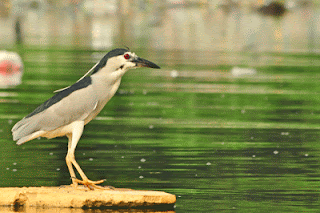Some 10 kilometers north of Manila stands Navotas City, an urban sprawl
long-known for its shipyards, fish-preparation plants, and fishponds. But thanks to the successful implementation
of the National Greening Program (NGP) in the area, Navotas may yet again become
famous for quite another remarkable development: the first locally established Marine
Tree Park in the National Capital Region.
 |
| This long, rickety bamboo bridge serves as the main access to the Navotas Marine Tree Park |
Created in 2011 thru Barangay Ordinance No. 4 of the Barangay Council
of Tanza, Navotas City, the Marine Tree Park is a testament to the strategic
importance of involving the local government in the conservation and ecological
rehabilitation efforts of the Department as now, the Barangay Council is active
more than ever in the greening program, as well as in other related activities.
 |
| Barangay Chairman Carlito M. De Guzman (in yellow shirt) of Tanza, Navotas is flanked by volunteers from the University of the Philippines-Manila |
Initially, in 2010, the DENR-NCR office, thru the Coastal and Marine
Management Division (CCMD) of the Protected Areas, Wildlife and Coastal Zone
Management Service (PAWCZM), recommended the 29.47 hectare coastal land in
Barangay Tanza as one of the major mangrove enrichment planting sites in NCR
under the NGP, home as it is to the only remaining old and naturally growing
mangrove stands in Manila Bay—a reminder of its once teeming marine and avian
ecosystem.
 |
| Young mangrove trees along the stream banks of Navotas Marine Tree Park |
To harness and maximize this interest, DENR-NCR conducted a series of
information and education campaign about the ecological functions of mangroves
and its potential economic contribution to the residents of the area. These were done firstly, among the local
barangay officials and later, at the community or grassroots level.
A stronger bond and understanding between DENR-NCR officers and the
local community resulted in these endeavors, culminating with the passage of
the ordinance declaring the area as a protected marine tree park.
In the two years that has passed since its establishment, the CMMD was
able to plant 20 hectares of mangroves.
This year, it aims to add another 10 hectares.
 |
| Mangrove nursery |
The
importance of mangroves to Navotas City cannot be understated. Lying below sea level, mangroves help mitigate
the impact of typhoons on the coastal city, says CMMD Chief Teresa Salanguit. Mangroves act as a natural buffer against
waves that surge towards the city during the onslaught of typhoons which, as a
result of climate change, becomes more frequent and stronger.
"Dense
mangroves provide good protection against sea surges," she added.
Aside
from protecting the coastal barangays of Navotas from environmental shocks and
stresses, mangroves play an important ecological function. Mangroves serve as food, nesting and nursery
grounds for various high-value aquatic resources. It also helps in filtering water by absorbing
pollutants. More importantly, mangroves act
as a carbon sink, absorbing and trapping greenhouse gases.
The
CMMD plans to repopulate the area with bungalon mangrove trees. The 'bungalon' is a mangrove specie that is
sturdy enough to withstand sea surges.
Bungalon trees once dominated Navotas' mangrove area but infestation by
the aroma beetle in the 1990s reduced its population.
Apart from extending the coverage of the mangroves in the
area, PAWCZMS
Regional Technical Director Donna Mayor-Gordove says that the agency plans to undertake
streambank stabilization in the area. Other
mangrove-related and beach type trees like the 'talisay' and coconuts will be
planted along riverbanks in the mangrove area to stabilize conditions.
Likewise, the agency is promoting more clean-up activities
in the mangrove area. Gordove said that
clean-up activities must be sustained because tidal flows bring to the area
assorted garbage such as plastic products, slippers and other items that are
dumped into the Manila Bay.
 |
| CMMD Chief Teresa Salanguit briefs volunteers during a coastal clean-up and mangrove planting activity in the area |
 |
| Volunteers from UP-Manila College of Medicine planting mangroves |
During one such activity for example, Gordove reports that volunteers
were able to recover some 500 sacks of garbage in less than 3 hours.
This makes, she concludes, the continuous coordination with Navotas
City officials, private organizations and other agencies regarding cleaning up
the area very critical.
Parties interested in doing volunteer work for the mangrove rehabilitation program in Navotas Marine Tree Park can contact
DENR-NCR at (02) 435-25-09 for details.
 |
| A pair of Little Egrets scouring for food along the beach. The Navotas Marine Tree Park also attracts a number of migratory bird species |
.jpg)

.jpg)
.jpg)
.jpg)
.jpg)
.jpg)
.jpg)
.JPG)
.JPG)

.JPG)
.jpg)

























